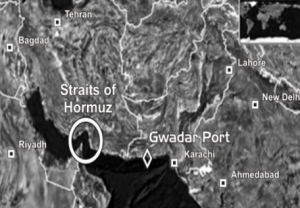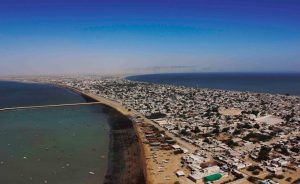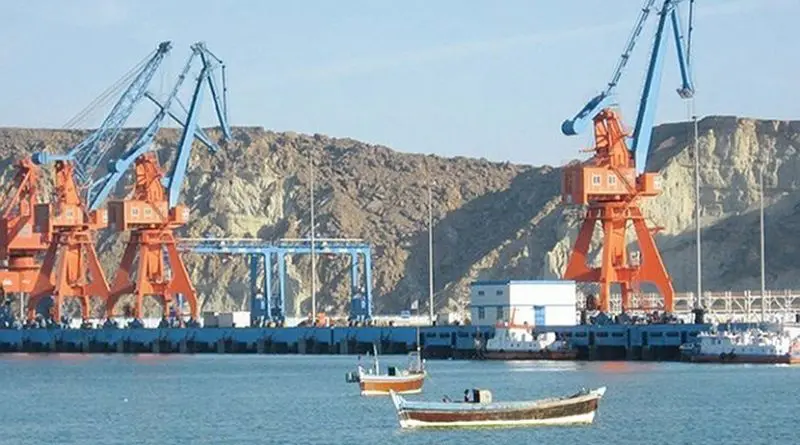Pakistan: The Emergence Of Gwadar As A Maritime Hub – Analysis
By Huma Kashif*
In the contemporary dynamics of the regional and global sphere, sea politics is gaining enormous focus due to securitization and economic expansion tenacity. The strategic position of the deep seaport of Gwadar, situated at the heart of the Persian Gulf, and Strait of Hormuz capturing the trade of approximately, 2/3 world’s oil reserves has the potential for becoming an international trading hub and transforming Pakistan’s economic outlook.
Gwadar is a vital port for connecting three strategic regions, i.e. South Asia, Central Asia, and the Middle East in terms of oil and gas resources and trade impetus. The Gwadar port would provide a substitute route to the Indian Ocean or the South China Sea when the Strait of Malacca can be restricted by India. As Gwadar is attracting a huge chunk of foreign investors to initiate innovative economic ventures and developmental projects it can be converted into a pivot of regional as well as international trade ventures.

Gwadar Port, located on the Arabian Sea in the Balochistan province of Pakistan has a strategic role in the mega China-Pakistan Economic Corridor (CPEC) project, which is supposed to be the main concern of economists ever since the declaration of the multi-billion dollar strategy. It is placed as the second greatest venture of Pak-China economic cooperation after the Karakoram Highway connecting China and Pakistan. The Port is around 630 km away from Karachi and 120 km from the Iranian border. Positioned at the entrance of the Persian Gulf, Gwadar has immense geostrategic worth on numerous accounts. While, persistent unstable regional environment as a result of the US-Iran escalation, the emergence of the Central Asian States has added to this importance. The statistical survey also revealed that approximately, more than $40 million has been invested till yet in Gwadar port for the up-gradation process and infrastructural development (1). Since March 2018, the port is entirely operational and receiving commercial containers consistently.
Gwadar port has a huge scope and tremendous potential to rise as a distribution and logistics hub in the regional hemisphere. While the geo-economic standing of CPEC is vibrant to usher a new era of developmental evolution and potential to emerge as “a game-changer” for Pakistan’s further socio-economic progression. The process of its structural expansion is underway in and around Gwadar to convert it into an advanced logistics hub such as Dubai, Singapore, and Hong Kong along with its status of “Duty-Free Port” and a “Free Economic Zone”.
Analysts define a logistics hub as the cohesive epicenter for transshipment, transportation, collection, storage, and distribution of goods for national as well as international transit, on commercial basis. Gwadar port is extremely systematic to the country’s transformation due to its deep-sea, and five new docks having the capacity to handle bulge of big cargo Ships and further transport the containers after loading them. The logistics hub will provide not only traditional activities such as storage, but also value-added logistics services such as labeling, assembly, semi-manufacturing, and customizing. As Gwadar port is tinted as the future port of global investors, and technology parks due to its geography, it also has a wider scope and prospects of appearing as a center of trade and commerce facilitating at least 20 countries within the Asian region. Thus, China is intensely concerned with Gwadar and pouring enormous investment.

Gwadar’s free port plan promises massive investment, employment opportunities, and more developmental projects in diverse zones. Commerce, industry, trade and economic activities would receive a boost after the development of this seaport. Moreover, a fully functional Gwadar port will boost the industrialization process in the province of Balochistan. With the functioning of the industrial zone, Gwadar would become a hub of industrial and trade activities. The Free Trade Zone and Export Processing Zone (EPZ) will open the doors for small as well as large scale investment and generate revenue for the government. Gwadar is also strategically important for China, as 60 % of its oil import devises in the Gulf region and proceeds through the Strait of Hormuz, which is 650 km away from Gwadar, a gateway for a third of the global petroleum trade, whereas the Chinese port of Xingjian is 15,000 kilometers away (2). Through Gwadar, crude oil is transported to China’s far western region Xinjiang overland by pipeline and the upgraded 1,300-kilometer Karakoram Highway and providing profitable avenues for both the skilled and non-skilled workforce in Balochistan.
During Chinese President Xi Jinping’s 2015 visit to Islamabad, Pakistan and China signed an agreement to start work on the $46 billion China-Pakistan Economic Corridor, or CPEC, a network of infrastructure and energy projects. The CPEC corridor, an integral part of Beijing’s $900 billion Belt and Road Initiative (3), Gwadar became the ultimate point from one of the six economic corridors proposed by China.
By all accounts, the future of Gwadar port and the free economic zone is glowing. That was why during Saudi Crown Prince Mohammed Bin Sultan’s visit to Islamabad, $8 billion of the $20 billion his government committed to invest in Pakistan were earmarked for an oil refinery in Gwadar (4). China is emerging as a super economic power of the world in recent years. Despite occupying a huge area of the world’s land, it doesn’t have any port of hot waters, which can be used for the whole year. As compared to this, Gawadar port is only on a distance of 2500 km from China and the port is working for the whole year because of the accessibility of the hot water.
Therefore, the interest of China in the development of Gwadar port is infect in the interest of the Chinese economy. Gawadar is now destined to be the most important upcoming coastal town located on the junction of the three most strategically and economically important regions of the world that are oil enrich the Middle East, and South Asia where one- fifth of world population lives and the Central Asian Republics endowed with mineral wealth having highly educated, skilled, and disciplined workforce. Given the changing geostrategic scenario in the Indian Ocean Region (lOR), reorientation of policies and the emergence of new alliances will continue to haunt the littoral states particularly Pakistan.
Modernizing, upgrading and enhancing the security mechanism has to be undertaken on priority. The recent Saudi announcement of investment in an oil refinery in Gwadar of $10 billion (5) indicates how the world has started taking Gwadar seriously.
Gwadar is the extremely important gateway city to the $62 billion China-Pakistan Economic Corridor (CPEC) which is the flagship project of China’s broader $5 trillion Belt and Road Initiative (BRI) (6). Although, A multifaceted approach is needed to meet all the security challenges by beefing up the security of Gwadar Port, directing security guards, coastal exercises and increasing maritime domain awareness in the region by engaging law enforcement agencies. The foundation of the New Gwadar International Airport (NGIA) positioned at a distance of 26 km from Gwadar Port, will be the biggest airport in Pakistan in terms of area (4,300 acres) and the second airport in Pakistan which can handle the landing of Airbus A380 and Boeing 777 airplanes.
China is financing the initiative to build such a huge airport in Gwadar with an approved grant of US$230 million (7), hope to be completed in three years. This airport will be a great source to provide air connectivity between China and Gwadar port. No doubt, the Gwadar Port is presenting a marvelous opportunity to benefit from the Sino-Pak friendship while gaining strategic leverage in its dealings with India and the US, having the potential for becoming an international trading hub and transforming Pakistan’s Economic outlook.
CPEC, as a great opportunity for the maritime sector, has also resulted in the growth prospects for Pakistan’s shipbuilding industry. Pakistan despite having few merchant ships in its inventory and almost total dependence on sea trade, has not taken any effective measures to exploit the shipbuilding sector. Whereas Pakistan is offering cheap labor as compared to China approximately 82% less i.e. roughly 0.59 – 0.81$ per hour paralleled to 3.32 – 4.49$ per hour (8). So, the establishment of a new facility at Gwadar can cater things in many ways for which endeavors of the CPEC structure would be instrumental for productive results.
The supposed plan for constructing a new shipyard at Gwadar is still awaited. The federal government needs to be clear in setting its priorities and determining a comprehensive financing model approach for it. Altogether, this initiative at Gwadar should set-up a state-of-the-art facility capable of repairing and building ships up to 600,000 DWT to provide regional and global demands (9). Although, the port is facing several challenges such as lack of connectivity, and infrastructural upheaval. There are also security concerns that need to be addressed.
Currently, India is using all tactics to counter the Gwadar port initiative. It is heavily investing in the Iranian port of Chahbahar. Moreover, Gwadar is a nearby place for the hub of global shipping lines which would offer a better business opportunity, particularly for ship repair and maintenance. It is considered to establish the facility in the form of a joint venture with foreign investors and the Pakistan Navy is supporting this initiative as well. But, the government’s roadmap should be clear in this regard. For a new, innovative and more competitive brand under CPEC endeavors, prioritization and comprehensive framework is essential to utilize progressiveness and further advancement. It is extremely required that Pakistan should address the prevailing challenges to expedite work on Gwadar port which is the key to Pakistan’s economic prosperity, regional connectivity, and maritime expansion.
*Huma Kashif is working as an independent researcher with a Research think tank based in Islamabad, Pakistan. Huma Kashif holds a Postgraduate degree in International Relations from Quaid-e-Azam University, Islamabad and has a keen interest in writing about International politics, Political Economy and Geopolitics of Eurasia.
Notes:
- S. Kamal Hayder Kazmi, “Gwadar Port’s Mass Trade Benificial Interest”, Sep 2019, Pakistan &Gulf Economist. http://www.pakistaneconomist.com/2019/09/16/gwadar-ports-mass-trade-beneficial-interest/” http://www.pakistaneconomist.com/2019/09/16/gwadar-ports-mass-trade-beneficial-interest/ http://www.pakistaneconomist.com/2019/09/16/gwadar-ports-mass-trade-beneficial-interest/””. Kamal Hayder Kazmi. Kamal Hayder Kazmi
- “The Strait of Hormuz is the world’s most important oil transit chokepoint”, June 2019, US Energy Information Administration. https://www.eia.gov/todayinenergy/detail.php?id=39932
- Tom Phillips, “The $900bn question: what is the Belt and Road initiative?”, May 2017, The Guadian. https://www.theguardian.com/world/2017/may/12/the-900bn-question-what-is-the-belt-and-road-initiative
- Joseph Hincks, “Saudi Arabia Is Investing $20 Billion in Pakistan. Here’s What It’s Getting in Return”, Feb 2019, Time. https://time.com/5531724/saudi-arabia-pakistan-mbs-imran-khan/
- Gul Yousafzai, “Saudi Arabia to set up $10 billion oil refinery in Pakistan”, Jan 2019, Reuters. https://www.reuters.com/article/us-saudi-pakistan-economy/saudi-arabia-to-set-up-10-billion-oil-refinery-in-pakistan-idUSKCN1P60OU
- Murtaza Ali Shah, “’Gwadar — Asia’s Emerging Trade Capital’ campaign starts on London buses”, Feb 2019, The News. https://www.thenews.com.pk/print/426156-gwadar-asia-s-emerging-trade-capital-campaign-starts-on-london-buses
- Ibid.
- “Pakistan’s labour costs lower than India’s and China’s,’ says Lead Economist, World Bank, South Asia Region”, Dec 2016, Business Recorder. https://fp.brecorder.com/2016/12/20161223116449/
- Kanwar Muhammad Javed Iqbal, “Promising prospects for Gwadar Shipyard under CPEC”, Jan 2020, Pakistan Observer. https://pakobserver.net/promising-prospects-for-gwadar-shipyard-under-cpec/

